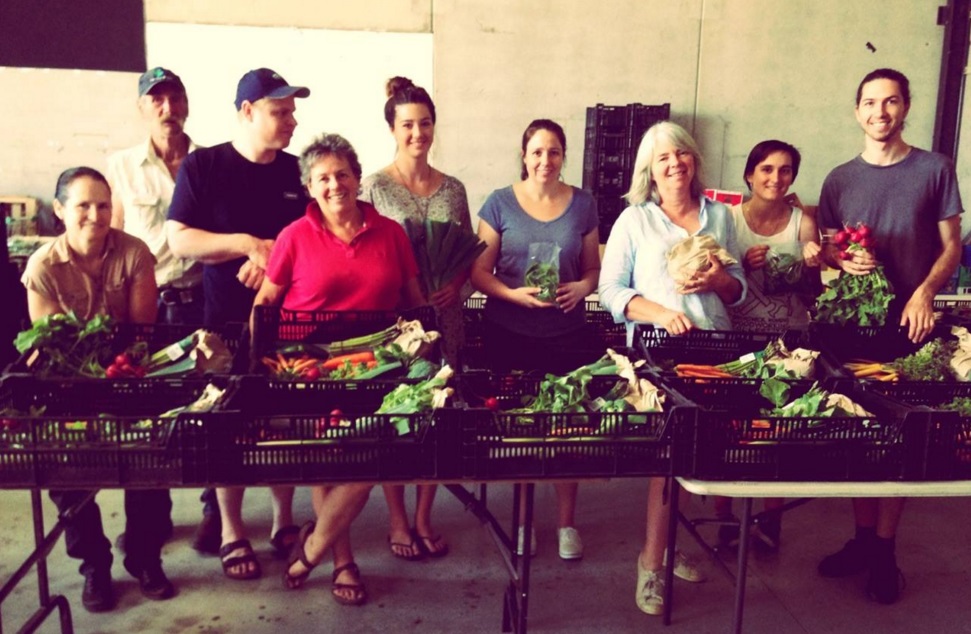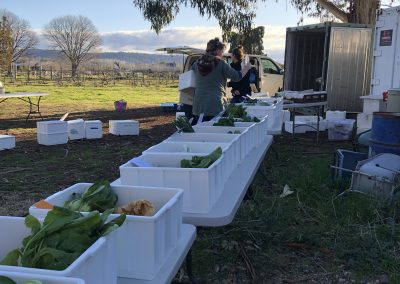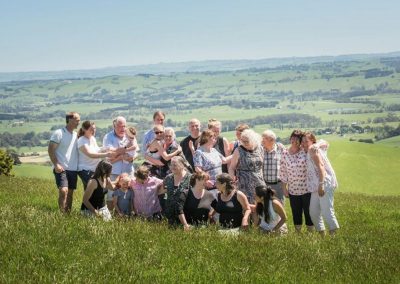Case Study
Baw Baw Food Hub
Background
The Baw Baw Food Hub is a non-profit group based in Warragul, in West Gippsland, Victoria. The hub sources local produce from organic and natural farmers in the region and makes this available to local customers throughout the year. Customers are encouraged to sign up for a ‘season’s’ worth of produce, in the form of mixed boxes which they pick up weekly. The hub’s consistent growth since its inception in 2013 is evidence of strong support from the hub’s broad and diverse customer base.
The hub operates under a number of core values which include improving the accessibility of quality food to everyone in the community; promoting the value the West Gippsland region’s produce; supporting fair prices for farmers; encouraging land stewardship and agricultural diversity; and championing alterative food distribution business models.
Getting started
Baw Baw Food Hub was founded in the summer of 2013 by Linda and Liz, market farmers in West Gippsland. The pair were attending farmer’s markets each weekend to sell their diverse range of fruit and vegetable produce, both locally and in Melbourne. However they were frustrated to see that crops which ripened during the week were going to waste because there was no market to sell them at. Preferring to sell the produce fresh, rather than refrigerating, they decided to explore the possibility of selling some produce mid-week to the local community.
In the early stages, the veggie boxes were comprised entirely of produce grown on their farms. The boxes were packed on one of the farms and taken into Warragul, where customers met in a local car park to pick up their box. Knowing this wasn’t sustainable, the Baw Baw Food Hub soon found a local space to operate out of, which functioned as their packing shed and collection point. This small, affordable veranda space was crucial to the Hub in its early days.
Initially, the veggie box scheme was run only for the summer season, when produce was bountiful. This summer season trial proved a success and the founders were eager to continue the initiative all year around, but knew the Hub would need to partner with other suppliers, to ensure they had adequate volumes and variety of stock. To this end, the hub formed arrangements with other local producers to supply produce, making it possible to supply veggie boxes throughout the year.
Startup Challenges and Resources
As the hub’s operational model was emerging, the founders looked to academic literature and case studies from the food hub movement in the USA. The alternative, local food distribution movement is more developed in North America and a lot of the Baw Baw’s thinking was informed by literature emerging from the US. Another resource the hub drew from included advice from generous legal and accounting professionals, who provided guidance and support around establishing the legal structure of the entity, which was one of the most challenging parts of getting set-up.
Rob, who has been deeply involved with the hub from the start, described the early days of the hub as manic, as systems were not yet in place to ensure all facets of the operation went smoothly. He acknowledges how essential the patience, commitment and support of the first customers was in enabling the hub to iron out kinks during the early phase, when trial and error dominated. He suggests that others starting hubs should also expect a steep learning curve in the initial phase of operation and where possible should start with a small and committed group of customers.
Core Values
To the Baw Baw Food Hub, success can be measured by the level of engagement there is around the hub, including from their customers, their suppliers and the broader community. This engagement may take the form of a customer enjoying quality produce and learning about where their food has come from. Or it may be through encouraging other producers to consider getting involved with the hub, or to start their own alternative food distribution models.
In 2014, in their effort to engage producers the hub invited local producers and budding market farmers to attend a full day workshop where they networked and shared ideas about different business models and alternative ways of distributing food. The day was well attended and Baw Baw was pleased to share ideas, tools and resources with other producers.
The hub has also hosted functions to engage their customers and volunteers more deeply in the operation, including farm walks and film screenings. Such events help them to communicate the value of the hub while also contextualising the project within the scope of the broader alternative food movement.
Baw Baw Food Hub’s Operational Model
Ordering
The Baw Baw Food Hub encourages customers to subscribe to a season’s worth of veggie boxes, usually for 10-12 weeks. Subscribers get a cheaper price than casual customers, who only comprise of 10-15% of orders each week. From the hub’s perspective, this keep the level of demand more stable and gives greater certainty. It’s also a way of compelling customers to make a habit of their new vege box pick up routine. Customers forgetting to place orders or forgetting to pick up their box can be a challenge hubs that don’t operate on a subscription basis. Customer can register for a season any time leading up to the first delivery, and they can also join part way through a season, simply paying up front for however many weeks remain in that season. Currently the hub is packing over 150 orders each week. In addition to packing the mixed boxes, a large part of the hub’s turnover is from add ons that customers can order on the Open Food Network in addition to their regular box subscription.
Customers
There is great variety in the demographics of the hub’s customers, who include young and old, families and singles, people from Warrigul and people living on properties outside of the town. While many of Baw Baw’s customers are highly engaged in the alternative food movement, others are not. To the Baw Baw team this is a good things for it shows that the hub is appeals for its price, convenience and freshness, in addition to its local, clean and green credentials.
Managing customer expectation is often a challenge when operating an alternative food distribution model. Baw Baw has seen that some customers are less willing to eat seasonally during the winter and spring seasons when variety can be limited. Alternatively, some customers prefer to grow their own vegetables during the warmer months, and reduce their subscription during this time. The hub has not found that being uncertified organic has deterred customers. The hub builds trust around their produce by carefully selected suppliers and also encouraging producers to mingle with customers during pickup from time to time, giving customers the chance to learn about how their food was produced.
Suppliers
Baw Baw sources from 10-15 suppliers each week and 20-30 over a year. The hub will send its supplier a rough order each Wednesday with further updates throughout the week. By Sunday night, orders are finalised and producers can prepare the order for Tuesday’s delivery. Each week the Baw Baw team makes one trip to collect produce from their larger suppliers. All other produce is delivered to the hub by the producers. The hub has found that their larger suppliers are too busy to deliver, whereas smaller, more local producers can accommodate delivering their produce.
Historically Baw Baw have primarily approached suppliers who meet the hubs supply criteria, to arrange supply agreements. The hub is not strictly organic, or certified organic, however the hub is careful to only partner with supplying producer who they have met and whose farming practices they agree with. In some cases, the hub must choose between suppliers, who offer the same product. In this case they prioritise suppliers who are local and organics first, those who are local secondly, or organic third, and finally those who are neither local or organic.
Product range
Initially the hub purely stocked local fruits and vegetables . As the hub has grown they have taken on additional local suppliers, and expanded their product range to include eggs, preserves, breads, dairy, frozen berries and meat. The dairy, eggs, preserves and frozen products are purchased by the hub and held on the premises. The hubs needs to turn perishable products over rapidly, keeping products like yoghurt for only one week, whereas preserves can be held for longer.
During the winter and spring periods, the hub supplements the local offerings with food from further afield, purchased through the wholesale market. These products are delivered by a local supplier who is already visiting the markets, reducing additional food miles associated with attaining the produce.
Each week the contents of the individual mixed boxes is determined using a complex spreadsheet, which takes into account the cost of the box, the variety of goods and the quantity going into each box size. This time consuming task has been made much easier through the development of a robust spreadsheet developed by the hub.
Marketing
So far the hub hasn’t invested huge amounts of time or resources into marketing and promotion, finding that most new customers hear of them through word of mouth. However the hub does spend some time being active on social media, sending regular newsletter and keeping their website up to date and engaging.
Staff
There is also around 30-40 hours of paid work which goes into managing operations of the hub including managing the stock, dealing with suppliers and taking care of orders. In addition, the hub is also supported by volunteers who assist with packing orders and working on the till during the collection times and also help with communications such as writing newsletters. In total the hub estimates that they receive around 15 volunteer hours each week.
The Future
The hub has just recently relocated to a larger warehouse in Warragul, which has more space and refrigeration facilities. With this new location come new opportunities to grow in size and scope. However, the hub recognises that at each stage of growth different constraints become the limiting factor, and viability means something different at each stage. For instance, when shifting from a low rent space to a higher rent warehouse, the required number of orders to break even rises. And similarly, as the hub accepts more orders their truck will soon reach capacity, demanding a rethink of their logistics and distribution methods. For Baw Baw, they foresee that soon in order to continue expanding the number of orders they process each week, it will become necessary to start a second delivery day. This is an exciting prospect for the hub, who relishes in seeing more producers selling locally, and more customers learning about and enjoying the region’s quality produce.

Other Open Food Network Case Studies
Can we help?
Have an idea, a project or a question? Want help using the Open Food Network software? Get in touch and find out how we can help you with it.
Keep in touch
Join us
Create a listing, shop or group directory on the Open Food Network. Tell me more!

Read our Terms and conditions | Find us on GitHub
Open Food Network is a free and open source software platform. Our content is licensed with CC BY-SA 3.0 and our code with AGPL 3.
We take good care of your data. See our cookies policy




